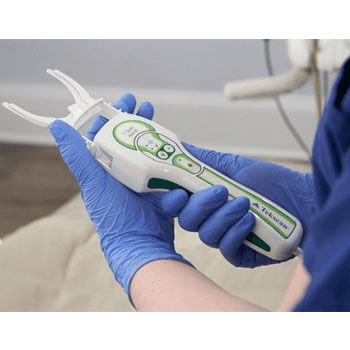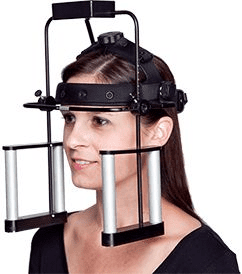Dental lasers address a variety of issues — everything from teeth whitening to treating gum disease and canker sores and surgically reshaping your gums, making them handy and versatile tools. When you need any type of dental work done, the last thing you want is an uncomfortable procedure and a prolonged, painful recovery time. One of the major benefits of using lasers in our practice is that they cause less swelling and bleeding, which mean you heal faster.

Nearly EVERY dental procedure performed impacts occlusion! Poor occlusion affects quality of life. T-Scan™ provides dynamic occlusal measurement – revealing the level and timing of force on individual teeth and the occlusal stability of the overall bite.


JT-3D, or “Jaw Tracking”, allows Dr. Powell to analyze jaw movement in a dynamic way. The most relevant procedures include chewing, speaking, range of motion, and swallowing.

Surface EMG is the worldwide standard method for recording muscle-specific activity in skeletal muscles. It has been proven reliable in numerous studies over many years and is a clinical procedure that can easily be performed in Dr. Powell’s office. This information is invaluable to creating beautiful dentistry that works with the patient’s physiology for optimum results.

The goal of the M-Scan™ project is to provide an extremely simple, fast and accurate means of evaluating splint efficiency in the office.

3D dental imaging is rapidly becoming the standard of care in all of dentistry, not just specialty fields. A cone beam CT captures digital images of teeth, soft and hard tissues, and nerve pathways. With a single 360-degree pass around the head, the CBCT can capture more precise images than 2D X-rays. These images can be used across many different applications. Digital images are superior to a typical pano or intraoral image, spotlighting areas not visible any other way. Recently, we had a patient come in with extreme tooth pain. Dr. Powell took a 3-D image and was able to diagnose one root had a fracture and the tooth needed to be extracted. With a cone beam in-house there is no need to send our patients driving across town or waiting days or weeks for another appointment at a different office. Within a few minutes Dr. Powell can view those images with you and discuss next steps. It’s quick, simple, and easy.
We are proud to say we have been offering digital x-rays in our office since 2001. Dr Powell Sr was one of the first dentists in the area to embrace digital x-rays, which are now a standard of care in the dental industry. Digital x-rays have many advantages over regular (plain film) x-rays including: Immediate viewing of the imaged area with significantly less radiation exposure for the patient. Better visualization of the area due to your doctor being able to digitally enhance the image on the computer screen.
that dental x-rays deliver very low levels of radiation and are considered completely safe? In fact, x-rays are even considered safe during pregnancy and while breastfeeding so long as a leaded apron and collar are used to protect your body from exposure. If you are pregnant or think you may be, tell your dentist so proper precautions can be taken.
Yes. Dental x-rays are capable of identifying tooth decay and damage beneath the surface of the teeth where caries are less visible during an examination. Furthermore, x-rays provide a reference point for the progression of decay in your mouth over time. You should have x-rays taken on a regular basis, but especially if you are experiencing oral health complications or are planning to undergo a dental procedure, such as a root canal.
Getting traditional dental x-rays can take several minutes. A thick paper tab is placed into the mouth, which you will be asked to bite down on. Most patients find that dental x-rays are completely painless and do not inflict any level of discomfort. In some cases, dentists intraoral x-rays, as well as extra-oral x-rays that snap images of the face, jaw and skull. Extra-oral x-rays are typically used to identify impacted teeth, such as wisdom teeth.
Your x-rays will be saved either on film or digitally. In the future, your dentist may request additional dental x-rays every few years to monitor the health of your teeth, gums and jaw over time. If you are considered to be high risk for oral disease or are exhibiting symptoms of complications, your dentist may prefer to take x-rays more frequently.
Medical technology has been advancing at a breakneck pace for the past several decades, and dentistry hasn’t been left behind. Dental professionals are constantly looking for the newest forms of treatments and technology that will aid in providing their patients with the best possible care, and we’re going to introduce you to some of the newest advancements that have been made.
This technology employs a special form of light that our dentists use to detect dental abnormalities. VELscope is particularly effective in the detection of disease and cancer in its earliest stages as part of an oral screening.
A common concern of patients is the amount of radiation they’re exposed to during a dental exam. The newest forms of imaging technology employ digital x-rays, which not only employs 90% less radiation than traditional x-rays but provides viewable films to the dental staff immediately. These images are able to be zoomed in on for highly accurate assessments of dental health.
For decades braces have been the go-to method of straightening misaligned teeth. While effective, braces are uncomfortable and unsightly. Invisalign is an innovation in this area of dental care that provides the benefits of braces while remaining nearly invisible. Additionally, Invisalign can be removed when eating, removing dietary restrictions associated with braces.
Past techniques for whitening, reducing tooth sensitivity, tumor removal, and filling cavities have often been uncomfortable for the patient, and time-consuming. New innovations in laser technology have created painless alternatives that also aid in eliminating harmful bacteria.
Traditional dentures are often ill-fitting, uncomfortable, and prone to embarrassing mishaps like slippage. Modern dental implants provide prosthetic teeth that are nearly indistinguishable from normal teeth and are long-lasting.
This innovation uses ozone (O3) to rapidly kill bacteria and fungus painlessly. It also makes a great tool for detecting tooth decay and suppressing it before it becomes more advanced.
This cutting-edge technology is capable of detecting cavities in places that traditional x-ray techniques can’t locate. By employing DIAGNOdent your dentist ensures that no early signs of cavities go unnoticed, saving you time and money on future dental treatments.
This tool employs a special camera that provides well-defined and precise images of places difficult to see in a patient’s mouth with traditional imaging. Just one more tool to aid your dentist in a thorough and accurate assessment of your dental condition.
These are just some of the technologies that have been brought into common use in recent years in our dental offices. Every year we keep an eye out for new methods of treating our patient’s dental concerns by improving visibility, reducing discomfort, and aiding us in providing complete and thorough assessments. If you have any questions about the technology your dentist is using in your exams, don’t hesitate to ask! Curious patients are educated patients, and we love to encourage our patients to be knowledgeable about their dental care.